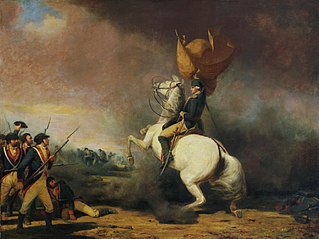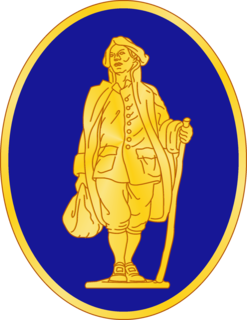This article needs additional citations for verification .(March 2014) (Learn how and when to remove this template message) |
| William Bradford | |
|---|---|
 A portrait of Bradford based on a portrait miniature in the possession of the Historical Society of Pennsylvania, published in the Pennsylvania Magazine of History and Biography in 1891 | |
| Born | 1719 New York City |
| Died | September 25, 1791 (aged 72 [1] –73 [2] ) |
| Resting place | "Presbyterian grave-yard in Arch-street", Philadelphia [2] (Arch Street Presbyterian Churchyard, formerly at 1724 Arch Street, Philadelphia?) 39°57′17.46″N75°10′8.83″W / 39.9548500°N 75.1691194°W Coordinates: 39°57′17.46″N75°10′8.83″W / 39.9548500°N 75.1691194°W |
| Citizenship | American |
| Occupation | Printer, soldier |
| Relatives |
|
William Bradford (1719 – September 25, 1791) was a printer, soldier, and leader during the American Revolution from Philadelphia.

The American Revolution was a colonial revolt that took place between 1765 and 1783. The American Patriots in the Thirteen Colonies won independence from Great Britain, becoming the United States of America. They defeated the British in the American Revolutionary War (1775–1783) in alliance with France and others.

Philadelphia, known colloquially as Philly, is the largest city in the U.S. state and Commonwealth of Pennsylvania, and the sixth-most populous U.S. city, with a 2018 census-estimated population of 1,584,138. Since 1854, the city has been coterminous with Philadelphia County, the most populous county in Pennsylvania and the urban core of the eighth-largest U.S. metropolitan statistical area, with over 6 million residents as of 2017. Philadelphia is also the economic and cultural anchor of the greater Delaware Valley, located along the lower Delaware and Schuylkill Rivers, within the Northeast megalopolis. The Delaware Valley's population of 7.2 million ranks it as the eighth-largest combined statistical area in the United States.
Contents
Bradford was born in New York City in 1719, [3] and was the grandson of the printer William Bradford. He was apprenticed to (and later a partner of) his uncle Andrew Bradford in Philadelphia. This relationship ended in 1741. He visited England that year, returning in 1742 with equipment to open his own printing firm as well as a library. [3]

Andrew Bradford was an early American printer in colonial Philadelphia. He published the first newspaper in Philadelphia, The American Weekly Mercury, beginning in 1719, as well as the first magazine in America in 1741.
Bradford was the publisher of The Pennsylvania Journal , the first number of which appeared on December 2, 1742. In later years each issue had the still-recognized image of the snake chopped into segments with the motto "Unite or Die". Variations of this logo were also used by Paul Revere, Benjamin Franklin, and others. In 1754 he also opened the London Coffee House in Philadelphia and began to write marine insurance. As a publisher and writer he attacked many policies of the British government, and was especially vocal in his opposition to the Stamp Act in 1765. [3]

The Pennsylvania Journal was an American weekly newspaper published by William Bradford during the 18th century.

Paul Revere was an American silversmith, engraver, early industrialist, and Patriot in the American Revolution. He is best known for his midnight ride to alert the colonial militia in April 1775 to the approach of British forces before the battles of Lexington and Concord, as dramatized in Henry Wadsworth Longfellow's poem, "Paul Revere's Ride" (1861).

Benjamin Franklin was an American polymath and one of the Founding Fathers of the United States. Franklin was a leading author, printer, political theorist, politician, freemason, postmaster, scientist, inventor, humorist, civic activist, statesman, and diplomat. As a scientist, he was a major figure in the American Enlightenment and the history of physics for his discoveries and theories regarding electricity. As an inventor, he is known for the lightning rod, bifocals, and the Franklin stove, among other inventions. He founded many civic organizations, including the Library Company, Philadelphia's first fire department and the University of Pennsylvania.
The first Continental Congress met in Philadelphia in 1774, and Bradford was named as the official printer for the Congress. In this role he printed the formal resolutions, broadsides, and documents such as the Declaration of Rights, that the Congress issued. [3]

The Continental Congress was initially a convention of delegates from several British American colonies at the height of the American Revolution era, who spoke and acted collectively for the people of the Thirteen colonies that ultimately became the United States of America. The term most specifically refers to the First Continental Congress of 1774 and the Second Continental Congress of 1775–81. More broadly, it also refers to the Congress of the Confederation of 1781–89, thus covering the entire period the Continental Congress served as the chief legislative and executive body of the U.S. government.
The Declaration and Resolves of the First Continental Congress, was a statement adopted by the First Continental Congress on October 14, 1774, in response to the Intolerable Acts passed by the British Parliament. The Declaration outlined colonial objections to the Intolerable Acts, listed a colonial bill of rights, and provided a detailed list of grievances. It was similar to the Declaration of Rights and Grievances, passed by the Stamp Act Congress a decade earlier.
When the American Revolutionary War started, Bradford left his business in his son's hands and, despite being middle aged, went into active military service with the Pennsylvania militia. He was made a major, and later promoted to colonel. He saw action at Trenton and Princeton, and at Fort Mifflin. Because the wound he received at the battle of Princeton continued to trouble him, when British forces withdrew from Philadelphia he resigned from the militia and returned to the city. [3]

The American Revolutionary War (1775–1783), also known as the American War of Independence, was an 18th-century war between Great Britain and its Thirteen Colonies which declared independence as the United States of America.

The Battle of Trenton was a small but pivotal battle during the American Revolutionary War which took place on the morning of December 26, 1776, in Trenton, New Jersey. After General George Washington's crossing of the Delaware River north of Trenton the previous night, Washington led the main body of the Continental Army against Hessian mercenaries garrisoned at Trenton. After a brief battle, almost two-thirds of the Hessian force was captured, with negligible losses to the Americans. The battle significantly boosted the Continental Army's flagging morale, and inspired re-enlistments.

The Battle of Princeton was a battle of the American Revolutionary War, fought near Princeton, New Jersey on January 3, 1777 and ending in a small victory for the Colonials. General Lord Cornwallis had left 1,400 British troops under the command of Lieutenant Colonel Charles Mawhood in Princeton. Following a surprise attack at Trenton early in the morning of December 26, 1776, General George Washington of the Continental Army decided to attack the British in New Jersey before entering the winter quarters. On December 30, he crossed the Delaware River back into New Jersey. His troops followed on January 3, 1777. Washington advanced to Princeton by a back road, where he pushed back a smaller British force but had to retreat before Cornwallis arrived with reinforcements. The battles of Trenton and Princeton were a boost to the morale of the patriot cause, leading many recruits to join the Continental Army in the spring.
His son Thomas had continued The Pennsylvania Journal during his absence. Now they became partners, and over the years expanded their publishing house. After William's death on September 25, 1791 Thomas continued their enterprise. [3] A second son, William (sometimes called William, Jr.), joined the Continental Army, became a lawyer and was later Chief Justice of the Pennsylvania Supreme Court and U. S. Attorney General. Thomas's son Samuel Fisher Bradford [4] continued the family tradition and is noted for the American printing of Rees's Cyclopædia .

William Bradford was a lawyer and judge from Philadelphia, Pennsylvania, and the second United States Attorney General in 1794–1795.

The Continental Army was formed by the Second Continental Congress after the outbreak of the American Revolutionary War by the ex-British colonies that became the United States of America. Established by a resolution of the Congress on June 14, 1775, it was created to coordinate the military efforts of the Thirteen Colonies in their revolt against the rule of Great Britain. The Continental Army was supplemented by local militias and volunteer troops that remained under control of the individual states or were otherwise independent. General George Washington was the commander-in-chief of the army throughout the war.

Pennsylvania, officially the Commonwealth of Pennsylvania, is a state located in the northeastern, Great Lakes and Mid-Atlantic regions of the United States. The Appalachian Mountains run through its middle. The Commonwealth is bordered by Delaware to the southeast, Maryland to the south, West Virginia to the southwest, Ohio to the west, Lake Erie and the Canadian province of Ontario to the northwest, New York to the north, and New Jersey to the east.
The following obituary of Bradford was published in the Maryland Herald on October 11, 1791:
PHILADELPHIA, Sept. 29.
Died, on Sunday morning in the 73d year of his age, Mr. William Bradford, many years the Editor of the Pennsylvania Journal, and Colonel of a regiment of militia during the late war. He was descended from one of the first settlers in Pennsylvania ; and was one of four generations of printers, who have uniformly distinguished themselves, by devoting to the Press to the preservation and extension of the liberties of our country. This venerable Patriot took an early and active part in every scene of difficulty and danger which occurred during the American revolution—Fear had no place in his breast ; nor did he ever in a single instance, betray or even disappoint the confidence which his fellow citizens placed in him—whether in the secret enterprizes of the cabinet, or in the open dangers of the field. His remains was interred on Monday afternoon in the Presbyterian grave-yard in Arch-street, attended by a large concourse of the inhabitants of the city, and particularly by the early and steady friends of the revolution, who can never recollect the important events of the year 1774, 1775, and 1776, without connecting them with the name of this Patriotic Citizen.— Maryland Herald (MD), October 11, 1791, p. 3










